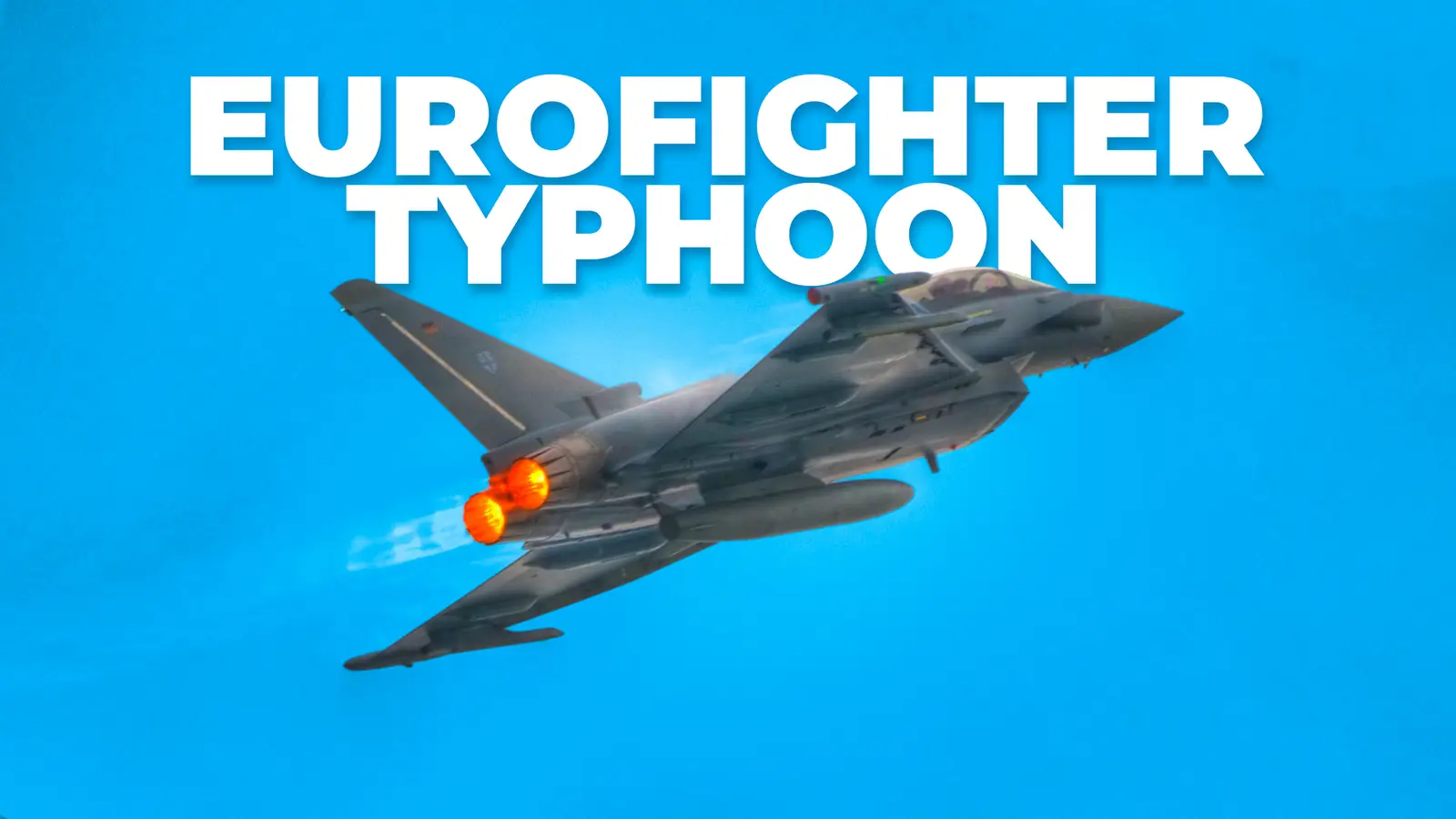
In modern air combat, where every second counts and threats can emerge from any direction, a pilot’s ability to understand and react to their environment is crucial. The Eurofighter Typhoon has earned a reputation not just for its speed and maneuverability, but for giving its pilots a level of situational awareness that few other aircraft can match. This edge isn’t just a result of raw technology; it’s the outcome of a design philosophy focused on keeping the pilot one step ahead in even the most complex and contested airspaces.
Unlike many of its contemporaries, the Typhoon was built with the pilot at the center of its mission system architecture. It’s not just about detecting more, it’s about understanding more, faster, and with greater clarity. The result is an aircraft that doesn’t just fly well, but thinks well alongside its operator. We’ll explore how this unique approach translates into a combat advantage, and why the Eurofighter continues to set the benchmark for situational awareness in modern fighter jets.
Origins of a Dominant Fighter Jet
The Eurofighter Typhoon’s story began in the late Cold War era. Europe recognized the need for a next-generation fighter to ensure air superiority in a rapidly evolving threat landscape. In response, the United Kingdom, Germany, Italy, and Spain joined forces under the European Fighter Aircraft (EFA) program to create a multirole combat jet that could meet the demands of both air-to-air and air-to-ground missions. This collaboration aimed not only to share costs and technology but to deliver a platform that would keep pace with, and surpass, rival aircraft being developed by the US and Russia.
Despite political disagreements, shifting defense priorities, and budgetary hurdles, the development was pushed forward throughout the 1980s and 1990s, with the prototype taking flight in 1994. After years of testing and refinement, the Typhoon entered operational service in 2003. Over time, it was adopted by all partner nations, as well as several export customers, gradually maturing into a frontline fighter across multiple air forces.
From the outset, the Typhoon was designed with more than just raw performance in mind. Its creators envisioned a jet that could give pilots a decisive edge by improving awareness and decision-making under pressure. This meant building an aircraft that could manage and present complex information in a way that felt intuitive and seamless in the cockpit. The emphasis on pilot-centric design and real-time battlespace understanding became one of the defining features of the Typhoon.
Sensor Fusion at the Core: Turning Data Into Dominance
At the heart of the Eurofighter Typhoon’s unmatched situational awareness is its advanced sensor fusion capability. The seamless integration of information from multiple onboard and external sources into a single picture. Rather than forcing the pilot to mentally piece together data from various systems, the Typhoon’s avionics suite automatically processes and filters inputs from radar, infrared sensors, electronic support measures, and datalinks. This condensed and prioritized stream of information gives the pilot a real-time, high-fidelity understanding of the surrounding environment, minimizing confusion and allowing for quicker, more confident decisions in combat.
The aircraft’s primary radar system, the Captor-M (and now Captor-E AESA in upgraded variants), delivers wide-angle tracking and multiple target engagement capabilities, offering exceptional range and clarity. It works in concert with the PIRATE (Passive Infra-Red Airborne Track Equipment) system, which allows for passive target tracking using heat signatures, particularly useful in stealthy or electronically contested environments.
This level of integration is what transforms the Typhoon from a fighter jet into an intelligent combat platform. The system not only displays the location of threats, allies, and environmental hazards but can also suggest optimal tactics, weapon selections, or evasive maneuvers. In essence, the jet doesn’t just provide raw information; it provides context and recommendations. By reducing the cognitive load and helping pilots interpret the ever-changing tactical picture, sensor fusion gives Typhoon operators a decisive edge, not just in knowing what’s happening, but in knowing what to do about it.
Pilot-Centric Design: Built Around Human Decision-Making
From the earliest stages of its development, the Eurofighter Typhoon was designed with a clear focus on optimizing the pilot’s effectiveness in high-intensity combat scenarios. Rather than overwhelming the operator with raw data, the aircraft’s systems were built to simplify complex information and present it in a way that enhances rapid decision-making. This philosophy, which places the pilot at the center of the combat system, shapes everything from the layout of the cockpit to the integration of voice controls and intelligent displays, ensuring that critical information is always within reach and easy to interpret.
The Typhoon’s glass cockpit is a prime example of this approach in action. Instead of traditional analogue instruments, the aircraft uses multi-function color displays that allow pilots to customize how information is presented, prioritizing data based on mission needs. Flight controls, weapons systems, threat indicators, and sensor feeds are all displayed in a logical, layered format that reduces cognitive strain. This enables the pilot to maintain situational awareness without needing to constantly switch between systems or manually interpret multiple data sources, significantly improving reaction time in fast-moving engagements.
The following data from Leonardo, displays the performance capabilities of the aircraft.
Another key feature supporting pilot-centric design is the implementation of voice command technology and hands-on throttle-and-stick (HOTAS) controls. These allow pilots to manage virtually all major systems without removing their hands from the flight controls or their eyes from the task at hand. The result is a seamless and intuitive control environment that allows pilots to focus more on strategy and threat response, rather than system management.
The Power of the Helmet: Eyes on Target, Head-Up Always
One of the most defining features contributing to the Eurofighter Typhoon’s situational awareness is its Helmet-Mounted Symbology System (HMSS). This advanced system allows pilots to see critical flight and combat data directly on the visor of their helmet, no matter where they’re looking. Unlike traditional head-up displays (HUDs) that require a forward-facing line of sight, the HMSS enables pilots to maintain complete awareness even when scanning outside the cockpit.
The HMSS also plays a critical role in targeting and weapon employment. By simply looking at a target, a pilot can designate it for engagement, significantly reducing the time it takes to lock on and fire, especially in dynamic dogfight conditions. This “look, lock, launch” capability is a major leap in air combat efficiency, particularly when paired with high off-boresight missiles. The pilot no longer needs to maneuver the entire aircraft to point sensors or weapons at a threat, giving the Typhoon a substantial edge in close-range engagements and high-threat environments.
The following data from Leonardo, displays the total number of the aircraft ordered.
Beyond combat applications, the helmet system enhances flight safety and navigation. Symbology includes waypoint markers, friendly unit identification, and threat warnings, all superimposed in the pilot’s field of view, reducing the need to check cockpit instruments during critical moments. Combined with the Typhoon’s other systems, the HMSS turns the helmet into a central interface between the pilot and the aircraft, offering unparalleled awareness without sacrificing focus or speed.
Information Superiority in Coalition Warfare
In today’s complex global security environment, modern air combat rarely happens in isolation. The Eurofighter Typhoon is designed to operate seamlessly alongside allied forces, sharing real-time data through advanced data links that create a common operational picture for all participants. This connectivity allows pilots to see not only what their own sensors detect, but also intelligence gathered by other aircraft, ground stations, and naval assets. By integrating this wealth of information, Typhoon pilots gain an unprecedented level of situational awareness that extends well beyond their immediate surroundings.
This networked approach to warfare enhances mission effectiveness on multiple fronts. For example, it allows pilots to coordinate complex maneuvers, share targeting information, and receive timely updates about emerging threats, all while maintaining high speeds and focusing on their own tasks. The ability to “see through the eyes” of allied assets dramatically reduces blind spots and improves decision-making, giving Typhoon pilots the tactical advantage of superior knowledge and coordination during joint operations.
Moreover, this ability supports coalition missions where forces from different countries and services must work together smoothly. The Typhoon’s communication and data-sharing capabilities are designed to be compatible with NATO standards, enabling it to plug into a wide range of platforms and command systems. In an era where air dominance depends as much on information flow as on firepower, the Typhoon’s integrated communication networks empower pilots to act faster, respond smarter, and maintain air superiority as part of a unified, well-informed fighting force.
Continuing The Success Of The Eurofighter Typhoon
The Eurofighter Typhoon’s unparalleled situational awareness is a testament to decades of thoughtful design, cutting-edge technology, and a clear focus on the pilot’s needs in the heat of battle. By integrating advanced sensor fusion, intuitive pilot interfaces, helmet-mounted displays, and seamless data sharing with allied forces, the Typhoon ensures that pilots have a comprehensive and clear understanding of their environment at all times. This holistic approach transforms raw information into actionable intelligence, enabling faster decisions and more effective responses in the chaos of combat.
What truly sets the Typhoon apart is how these sophisticated systems work together to support the pilot rather than overwhelm them. The aircraft’s pilot-centric design reduces cognitive load, allowing operators to maintain situational awareness without distraction or confusion. With tools like the Helmet-Mounted Symbology System and networked datalinks, pilots can focus on strategy and tactics, confident that their aircraft is continuously managing and prioritizing critical information in real time. This synergy between human and machine is what gives the Typhoon its remarkable edge over other fighters.
As aerial threats continue to evolve and airspaces become more contested, the importance of superior situational awareness will only grow. The Eurofighter Typhoon’s design philosophy and technological innovations ensure that it remains at the forefront of this challenge, providing pilots with the tools they need to dominate the battlespace. Ultimately, the Typhoon is not just a fighter jet, it is a force multiplier that amplifies the pilot’s senses, intellect, and reflexes, securing air superiority for decades to come.



